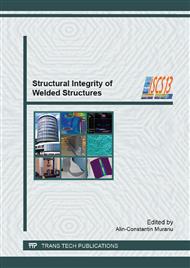p.19
p.25
p.33
p.41
p.49
p.54
p.60
p.68
p.76
Experimental Results on Micrometric Profile of Substrate and Thickness and Roughness of Deposited Layers through Thermal Spraying
Abstract:
Thermal spraying is composed of a group of processes in order to obtain thin films, where fine powders, metallic or nonmetallic, will be deposited in molten or semi-molten state to form a coating layer with the properties required for use. Few layers of stainless steel on usual steel substrates were deposited through thermal spraying deposition in different conditions. As anchor layer a nickel thin film was used between substrate and external layer. The materials surface was analyzed through scanning electrons technique using a VegaTescan LMH II microscope. Thermal metal spraying in electric arc was performed at different working distances which influenced the surface roughness of the deposited layers. To highlight these issues, the parameter of roughness (Rz) and (Ra) measurements were made of the corresponding obtained surfaces. Due to the fact that macroscopically it was noted an increased roughness, it was necessary that the experimental investigations to be conducted on a Taylor-Hobson equipment, model FormTaly Surf 50 (AMTEK, USA).
Info:
Periodical:
Pages:
49-53
Citation:
Online since:
September 2013
Authors:
Keywords:
Price:
Сopyright:
© 2013 Trans Tech Publications Ltd. All Rights Reserved
Share:
Citation:


